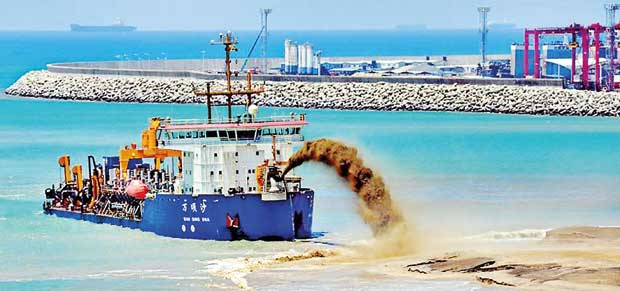Reply To:
Name - Reply Comment
Last Updated : 2024-04-19 00:00:00
 Colombo Port City project
Colombo Port City project
While the government was swift to release money for relief and compensation for those affected by the recent floods, the tendency of politicians and bureaucrats has been to blame the victims for the disaster. Officials have attributed it to illegal constructions along river-bank reservation areas, and people’s refusal to comply with directives to evacuate danger-prone areas.“Those who build illegal constructions obstructing waterways should know they are building their own graves,” said a statement from Minister of Megapolis and Western Development Champika Ranawaka, who also ordered the demolition of illegal structures. Minister of Disaster Management Anura Priyadarshana Yapa said government was considering bringing in laws to forcibly evacuate people in situations  where disaster was imminent.
where disaster was imminent.
While there is no denying that those living in danger prone areas are putting themselves at risk, doesn’t the government have a responsibility to prevent such needless loss of life? As the daily TV updates illustrated graphically, most of those who were struck down were poor.
Though politicians have chosen not to talk about the causes of the severity of the flooding in seven districts, environmentalists have repeatedly drawn attention to factors relating to flash floods which could be mitigated through better planning. They say landfills that destroy wetlands, that would normally accumulate run-off, have been a major contributory factor, along with haphazard building and poor drainage. Similarly scientists link the extensive landslides, which caused most of the deaths this time, to the quarrying of massive amounts of rock for an increasing number of mega development projects, that have created instability in the ground structure.
Regulating these matters clearly comes within the purview of government authorities. By focusing on the illegality of the squatters the government deflects attention away from its own lapses.
Dr. Ranil Senanayake, Sri Lanka’s only qualified Systems Ecologist, responding to questions on the causes of the recent tragedy said he would not call it ‘unplanned development’ but rather ‘irresponsible urbanization.’ Dr. Senanayake who is known internationally for introducing the concept of Analog Forestry (though regrettably his expertise is not made use of in Sri Lanka) said, “Development has taken place with no regards to the physical nor cultural geography. In most of the so-called ‘development’ projects, development seems to be either spending the borrowed money as fast as possible or carving out land for investment.”
When planning for development it should at least follow watershed boundaries he said. “Watershed boundaries are the lines that indicate where the rainfall moves to,” he explained, in an email interview. “The rainfall on one side of the boundary feeds one river while the rainfall on the other side feeds another river. One could say these are the lines that determine how the rainfall moves towards the ocean.”
The $1.4 billion Chinese-funded Port City - a huge complex consisting of luxury apartments, shops, restaurants, parks and a marina, to be built on land being reclaimed from the sea, is an example of a mega project involving a massive amount of rock-quarrying. Asked if this activity could be related to increased risk of landslides Dr. Senanayake said “Mega projects, demanding mega resources will have mega consequences. The quarrying for the Port City has already begun to impact the shallow aquifer. The geological activity in the area of the slides, the rock quarries, the charge impact allowed etc. must be part of the post mortem of the collapsed hills.”
Dr. Senanayake has written extensively on the dangers posed by lack of Scientific Environmental Impact Assessment (SEIA) reports relating to Port City. In a scathing critique of ‘the promoters of the project’ in a newspaper article last month he said “SEIA’s are being issued to cover any aspect of their crookedness, as it surfaces. This allows them to skirt national laws and genuine concerns that citizens have of impacts on their well-being.”
Referring to the 2014 landslide in Meeriyabedde, Koslanda, he told the Daily Mirror that “drilling and blasting fractured rock formations for the Uma Oya tunnel, certainly seems to be linked” to it.
So what is to be done? Dr. Senanayake says “the Government should immediately stop all non essential quarrying. It should ask for detailed impact reports before any rock quarrying can be conducted. The department on mines should be taken to task for allowing dangerous blasting that weakens the ground structure to carry on. At present it is given as a political ‘gift’ to hangers on etc. No standards, no concern for communities living around...”
Last month’s floods and landslides were a man-made disaster, he said. “... Starting with the fact that cyclonic intensity goes up 25% for each degree rise in sea surface temperatures and we have been contributing to the rise in global temperatures through our acceptance of fossil fuels to drive development processes.It was amplified by the filling up of the wetlands and increasing the impervious surfaces with urbanisation fuelled by the plastic and other domestic garbage choking our drainage.”
A problem that has come to light with the recent media focus on landslides is that Sri Lanka’s lead agency on landslide related matters, the National Building Research Organisation (NBRO) lacks the powers to enforce its own directives. According to its website “NBRO issues Landslide Risk Assessment Reports as a pre-requisite for granting of building permits and approval of development projects.” But it turns out these are assessments only. The issuance of permits is assigned to local authorities, according to NBRO’s Director of Landslide Research and Risk Management R. M. S. Bandara.
“Our approval is required. But people don’t come to us. It is a local government process” Bandara said. “We only give recommendations to the local government authority.
We can only recommend, we can’t enforce (the recommendations).” It’s anybody’s guess as to why the government has failed to empower the appropriate and qualified authority in a matter as important as issuing building permits and approvals for development projects. Given the recent rash of building collapses, landslides, roads caving in etc. around the country, along with the consequent loss of life, does it not amount to criminal neglect to assign this task to non-specialists? Or is it that this area is just too lucrative for politicians to lay their hands off?

Add comment
Comments will be edited (grammar, spelling and slang) and authorized at the discretion of Daily Mirror online. The website also has the right not to publish selected comments.
Reply To:
Name - Reply Comment
On March 26, a couple arriving from Thailand was arrested with 88 live animal
According to villagers from Naula-Moragolla out of 105 families 80 can afford
Is the situation in Sri Lanka so grim that locals harbour hope that they coul
A recent post on social media revealed that three purple-faced langurs near t

10 Apr 2024
09 Apr 2024